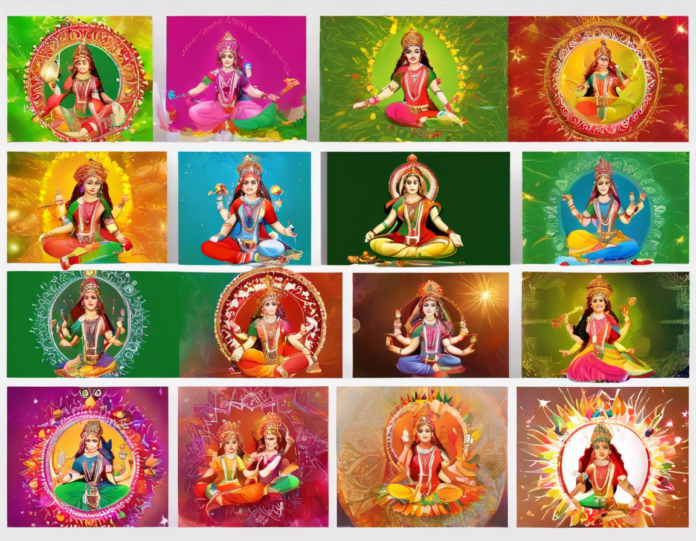Navratri, a nine-night festival celebrated with great fervor in India, is a time of vibrant colors, traditional dances, and devotional music. Each day of this festival is dedicated to one of the nine forms of Goddess Durga, and devotees dress up in specific colors to honor each day. These Navratri colors hold significant cultural and spiritual meanings, and wearing them is believed to invoke blessings and protection from the divine.
The Significance of Navratri Colors:
Navratri is a festival of worship and fasting, where each color symbolizes various aspects of life and invokes different qualities. Let’s delve into the significance of each Navratri color over the nine days:
Day 1 – Yellow:
- Yellow signifies happiness and brightness. It represents new beginnings and prosperity. On the first day of Navratri, devotees wear yellow to invoke the blessings of Goddess Shailputri.
Day 2 – Green:
- Green stands for growth, harmony, and nature. Devotees wear green on the second day to seek the blessings of Goddess Brahmacharini, symbolizing love and loyalty.
Day 3 – Grey:
- Grey denotes the strength and power required to face challenges. It represents Goddess Chandraghanta and is worn on the third day of Navratri.
Day 4 – Orange:
- Orange represents energy and happiness. It symbolizes courage and creativity and is worn on the fourth day to honor Goddess Kushmanda.
Day 5 – White:
- White symbolizes purity and peace. This color represents the calm and serene form of Goddess Skandamata and is traditionally worn on the fifth day.
Day 6 – Red:
- Red signifies power, passion, and transformation. On the sixth day of Navratri, devotees wear red to celebrate the fierce form of Goddess Katyayani.
Day 7 – Royal Blue:
- Royal Blue represents confidence and intelligence. It symbolizes the divine energy of Goddess Kalaratri and is worn on the seventh day of Navratri.
Day 8 – Pink:
- Pink symbolizes love, compassion, and purity. Devotees wear pink on the eighth day to honor Goddess Mahagauri and seek her blessings for a peaceful life.
Day 9 – Purple:
- Purple signifies luxury, power, and ambition. On the last day of Navratri, devotees wear purple to invoke the grace and wisdom of Goddess Siddhidatri.
Tips for Choosing and Styling Navratri Colors:
Celebrating Navratri in style involves not just wearing the right colors but also incorporating them elegantly into your attire. Here are some tips to help you choose and style your outfits for each day of Navratri:
- Mix and Match: Combine different shades of the Navratri colors to create unique and eye-catching outfits.
- Accessories: Add accessories like bangles, necklaces, or scarves in the specific color of the day to enhance your outfit.
- Makeup: Experiment with makeup in the designated color to complete your festive look.
- Ethnic Wear: Opt for traditional Indian attire like sarees, lehengas, or kurta sets in the Navratri colors for an authentic celebration.
Frequently Asked Questions (FAQs):
Q1: Can I wear the same color for all nine days of Navratri?
A: While it’s traditional to wear a specific color each day, you can choose to wear your favorite color on all nine days if that feels more comfortable or meaningful to you.
Q2: What if I don’t have outfits in the designated Navratri colors?
A: You can still participate in the festivities by accessorizing with items like scarves, jewelry, or even incorporating the colors into your makeup or nail polish.
Q3: Are there specific rituals associated with wearing Navratri colors?
A: While wearing the designated colors is a symbolic way to honor the Goddess during Navratri, there are no strict rituals associated with it. It’s more about personal devotion and celebration.
Q4: Can men also participate in wearing Navratri colors?
A: Absolutely! Men can choose to wear Kurtas or shirts in the designated colors to celebrate Navratri with equal enthusiasm.
Q5: Is there a specific order in which the Navratri colors should be worn?
A: Yes, the colors follow a specific order corresponding to each day of Navratri, as each color is associated with a different aspect of the Goddess Durga.
Navratri is a time for spiritual reflection, celebration, and cultural togetherness. By understanding the significance of each Navratri color and incorporating them into your wardrobe, you can fully immerse yourself in the festive spirit and pay homage to the divine feminine energy that the festival represents.












